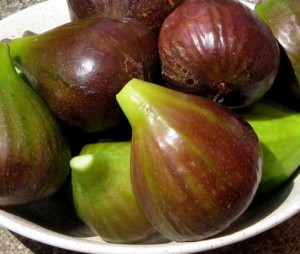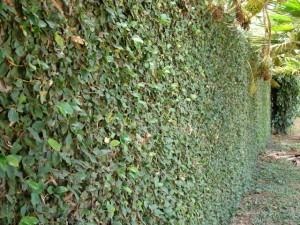Fig Tales
I have a confession to make. I'm scared of my fig tree. I keep it confined in a 20-gallon fiberglass container, and pick the occasional fig before the birds get it (and they keep just as close an eye on it as I do). I feed it, and give it all the sun that it needs (eight hours a day--figs are sunlovers), but I'm scared to plant it out into my landscape.
Why? After living in the frozen interior of the northwest, where figs did not grow, and then along the Santa Cruz coastline, where fog prevented my fig from ever getting ripe and sweet, I now live in a climate that figs love. And that's the problem. My neighborhood has to approve any tree over 8 feet, and I have to preserve the views of my neighbors. If I planted my fig into the yard, in five years it would have a 30-foot dense canopy. Its roots would break up my stone walls or dig under my house foundation, or eat small neighborhood pets.
But I love figs so much I might just do it anyway.
If you love the taste of fresh fig, and you have a little room away from your house to plant a tree, then please do so, and call me in five years to help with the harvest. But don't say I didn't warn you. Figs love to grow.
Consider some of the edible fig's (Ficus carica) close relatives. There's the rubber tree (Ficus elastica). You may know it as a well-behaved and hard to kill houseplant. But set that baby outside in Hawaii, or other tropical site, and you will see it spread to 60-80 feet, and up to 100 feet on the windward side of the islands in rainforest areas.
If you plant another relative, the Banyan or Indian Laurel (Ficus microcarpa), it will grow 60 feet tall and more than 75 feet wide, supported by a stand of aerial roots that themselves become as large as tree trunks.
Finally, consider the small cousin, the creeping fig (Ficus pumila), usually available at the local box store in an innocuous 1-gallon or 5-gallon pot. Let it settle its roots into real ground, and in a couple of years it will take over a three-story building. I once planted one against the wall of characterless subdivision I lived in as revenge. I figured that the entire complex would be vastly improved as a large green living mound. My only regret was that I didn't live there long enough to see the results of my labor.
You can buy a small fig tree from a nursery, start a cutting from an established plant, or even use a cutting off a root sprout. Start small, and prune it back after the second year. Each year, cut it back at least a third, or more if you are keeping it against a wall or in a small space. If you do want it to stay small, plant the roots in a buried container with drainage holes. Otherwise, stand back!
Once you have a fig planted, mulch it heavily (but keep the mulch away from the main stem by at least a few inches). No need to fertilize, as the mulch will take care of that. Moderate water is required when the tree is young. Once it is well-established, it is very drought tolerant, which is why one can still find fig trees at old homesteads, long after the occupants have been gone.
Figs are not only easy to grow, they are relatively pest free--and that's saying a lot in our Hawaiian landscapes. The biggest pest are the birds that will compete with you for the ripe fruit. You can use netting, or pick the fruit before it's fully ripe (though I prefer to take my chances). If you do see signs of whitefly, just give the leaves a washing with soapy water.
And then enjoy. There are white, brown Turkey, and black Mission figs. They are all good. Try them with a little fresh ricotta drizzled with local honey and chopped nuts. Or wrap prosciutto around them and bake in the oven until done. Mine never make it into fig jam or fig bars, though, because I never have enough.
Previous post: What to do with Mangoes?
Next post: Why Hire an Arborist



Comments on this entry are closed.